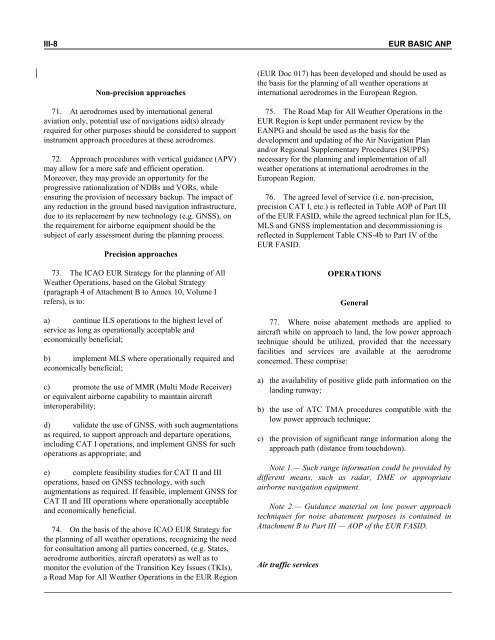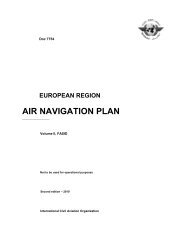7754 Vol 1 Flyleaf - ICAO Public Maps
7754 Vol 1 Flyleaf - ICAO Public Maps
7754 Vol 1 Flyleaf - ICAO Public Maps
Create successful ePaper yourself
Turn your PDF publications into a flip-book with our unique Google optimized e-Paper software.
III-8 EUR BASIC ANP<br />
Non-precision approaches<br />
71. At aerodromes used by international general<br />
aviation only, potential use of navigations aid(s) already<br />
required for other purposes should be considered to support<br />
instrument approach procedures at these aerodromes.<br />
72. Approach procedures with vertical guidance (APV)<br />
may allow for a more safe and efficient operation.<br />
Moreover, they may provide an opportunity for the<br />
progressive rationalization of NDBs and VORs, while<br />
ensuring the provision of necessary backup. The impact of<br />
any reduction in the ground based navigation infrastructure,<br />
due to its replacement by new technology (e.g. GNSS), on<br />
the requirement for airborne equipment should be the<br />
subject of early assessment during the planning process.<br />
Precision approaches<br />
73. The <strong>ICAO</strong> EUR Strategy for the planning of All<br />
Weather Operations, based on the Global Strategy<br />
(paragraph 4 of Attachment B to Annex 10, <strong>Vol</strong>ume I<br />
refers), is to:<br />
a) continue ILS operations to the highest level of<br />
service as long as operationally acceptable and<br />
economically beneficial;<br />
b) implement MLS where operationally required and<br />
economically beneficial;<br />
c) promote the use of MMR (Multi Mode Receiver)<br />
or equivalent airborne capability to maintain aircraft<br />
interoperability;<br />
d) validate the use of GNSS, with such augmentations<br />
as required, to support approach and departure operations,<br />
including CAT I operations, and implement GNSS for such<br />
operations as appropriate; and<br />
e) complete feasibility studies for CAT II and III<br />
operations, based on GNSS technology, with such<br />
augmentations as required. If feasible, implement GNSS for<br />
CAT II and III operations where operationally acceptable<br />
and economically beneficial.<br />
74. On the basis of the above <strong>ICAO</strong> EUR Strategy for<br />
the planning of all weather operations, recognizing the need<br />
for consultation among all parties concerned, (e.g. States,<br />
aerodrome authorities, aircraft operators) as well as to<br />
monitor the evolution of the Transition Key Issues (TKIs),<br />
a Road Map for All Weather Operations in the EUR Region<br />
(EUR Doc 017) has been developed and should be used as<br />
the basis for the planning of all weather operations at<br />
international aerodromes in the European Region.<br />
75. The Road Map for All Weather Operations in the<br />
EUR Region is kept under permanent review by the<br />
EANPG and should be used as the basis for the<br />
development and updating of the Air Navigation Plan<br />
and/or Regional Supplementary Procedures (SUPPS)<br />
necessary for the planning and implementation of all<br />
weather operations at international aerodromes in the<br />
European Region.<br />
76. The agreed level of service (i.e. non-precision,<br />
precision CAT I, etc.) is reflected in Table AOP of Part III<br />
of the EUR FASID, while the agreed technical plan for ILS,<br />
MLS and GNSS implementation and decommissioning is<br />
reflected in Supplement Table CNS-4b to Part IV of the<br />
EUR FASID.<br />
OPERATIONS<br />
General<br />
77. Where noise abatement methods are applied to<br />
aircraft while on approach to land, the low power approach<br />
technique should be utilized, provided that the necessary<br />
facilities and services are available at the aerodrome<br />
concerned. These comprise:<br />
a) the availability of positive glide path information on the<br />
landing runway;<br />
b) the use of ATC TMA procedures compatible with the<br />
low power approach technique;<br />
c) the provision of significant range information along the<br />
approach path (distance from touchdown).<br />
Note 1.— Such range information could be provided by<br />
different means, such as radar, DME or appropriate<br />
airborne navigation equipment.<br />
Note 2.— Guidance material on low power approach<br />
techniques for noise abatement purposes is contained in<br />
Attachment B to Part III — AOP of the EUR FASID.<br />
Air traffic services














